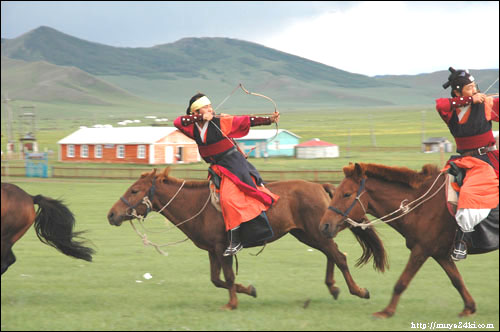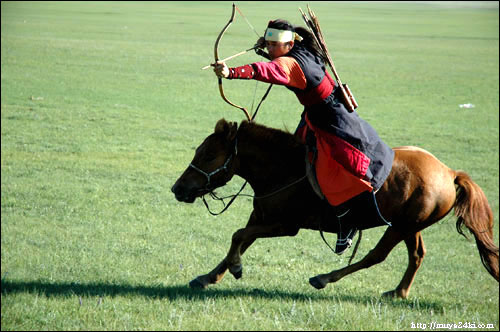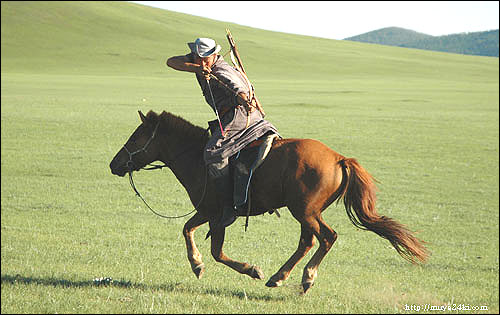
Posted on 08/31/2006 11:40:49 PM PDT by TigerLikesRooster
Some S. Koreans dug up old military training manuals from 18th century and are trying to restore the art of ancient warriors.
Here, they are practicing once-lost art of mounted archery. They went to Mongol steppe to do their summer training.
It was done this August on Arkhangel Aimac, a plateau which is 1,000 km from its capital Ulan Bator and 1,700 m (5660 feet) above sea-level .
The uniform they are wearing is from Chosun(1392~1910) era.
A trainee practicing so-called 'Parthian Parting Shot'
This is a favorite technique of Northen steppe warriors in the past. Koreans also used to use it.


More training shots of mounted archery



A Mongol cowboy joined the training, and was practicing the technique.
They lost much of their heritage during their communist era.
This is something new to this man, even though this was one of the main battle techniques
of Genghis Khan's troops.

Posing against a rainbow to get a nice photo

Ping!
Pinged for general coolness.
Experimental archeology is very "in" right now. There is much to be learned about how ancient cultures did things by actually getting out there and trying to do it.
nyuk nyuk nyuk... Curly(Howard) salute... exit stage right(Curly shuffle)..
The guy at the bottom is a history major and a warrior buff. This is part of his research in experimental archeology. You are right about it.
I was in Bhutan a few years ago and traditional archery ,using
traditional and compound bows was being practiced everywhere , in every town and village. Just the thing for when the bullets finally run out....
Interesting post
"The traditional composite bow they use is notoriously difficult to master".
If they hired these guys for the fight scenes in The Seven Samurai remake they wouldn't need to use CGI ping.
A Houston man who became a devotee of edged weapons spent years relearning the fighting skills of European swordsmen.....practiced with everything from 1-1/2 handers and bastard swords to the huge two-handed swords used by German Landsknechts under the Hapsburg emperors 500 years ago, to Scottish claymores to rapiers to sabers to epees. His conclusion was that European swordfighting was a truly deadly art in few ways inferior to Japanese swordsmanship, but that it declined severely in the 16th, 17th, and 18th centuries as the firelock gradually became the queen of the battlefield.
This guy still runs the European equivalent of a dojo for swordsmen. He was written up in Houston's alternative paper, The Houston Press, a few years ago.
The term is "Parthian shot", ictus Parthicus in Latin. "Parting shot" is a corruption of the correct term.
Um .... they're going to improve on the original ... how????
Seems ripe for disappointment.
A traditional bow should have a traditional arrow.
European swordsmanship truly reached its peak right around the time that plate armor became common and just before the firelock became popular. You *had* to be very good to get through the few vulnerable points in plate armor, and the techniques developed were also of a correspondingly high level.
In my opinion, assuming a sword fight between an unarmored 16th century samurai and an unarmored Western knight, the samurai is slightly more likely to win - but put both combatants in the best armor of the 16th century from their respective lands, and the Western knight is going to win, hands down. The armor (and reliance on same) makes all the difference.
From Central Asia to Mongol Steppe to Manchuria, all steppe people used the more or less the same art of war, and culturally similar, even though some could have been ethnically quite different.
Techniques of mounted warriors took a significant leap in N.E. Asia.
Very cool.
Yup, and a lot of things that were always dismissed as "impossible" for that culture to do have turned out to be not only possible, but easy.
Are they remaking that? In English or Japanese?
Disclaimer: Opinions posted on Free Republic are those of the individual posters and do not necessarily represent the opinion of Free Republic or its management. All materials posted herein are protected by copyright law and the exemption for fair use of copyrighted works.